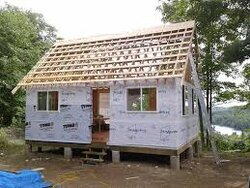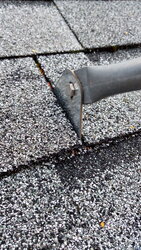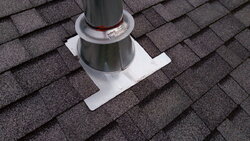It’s been repaired in the past as well. Notice the cdx plywood at the bottom.I lean toward insufficient ventilation in the roof. Notice how the OSB is crumbling but there is no appreciable rot in the framing? Why are the rafter bays insulated anyway? Is there a ceiling below the attic or is it a cathedral?
Roof Flashing Advice
- Thread starter KJamesJR
- Start date
-
Active since 1995, Hearth.com is THE place on the internet for free information and advice about wood stoves, pellet stoves and other energy saving equipment.
We strive to provide opinions, articles, discussions and history related to Hearth Products and in a more general sense, energy issues.
We promote the EFFICIENT, RESPONSIBLE, CLEAN and SAFE use of all fuels, whether renewable or fossil.
You are using an out of date browser. It may not display this or other websites correctly.
You should upgrade or use an alternative browser.
You should upgrade or use an alternative browser.
It’s been repaired in the past as well. Notice the cdx plywood at the bottom.
I do see that.
Why no ice sheild? I agree it should not be on the part below the flashing where it is exposed but i use it on every one that i pull shingles on both under the flashing then over it.
Just as you said, not on the visible part.
Roofing is a lot of fun. I have noticed that the newer composition has very aggressive and effective glue strips. I worry about doing repairs and modifications on it after it has sealed.
Rearscreen
Minister of Fire
I agree that when roofing isn't done right other methods need to be employed. "Through the Roof" adhesive got great reviews from my friend.
Ok then absolutly i agreeJust as you said, not on the visible part.
Roofing is a lot of fun. I have noticed that the newer composition has very aggressive and effective glue strips. I worry about doing repairs and modifications on it after it has sealed.
It has become increasingly difficult to get flashings in with these new shingles.Just as you said, not on the visible part.
Roofing is a lot of fun. I have noticed that the newer composition has very aggressive and effective glue strips. I worry about doing repairs and modifications on it after it has sealed.
RandyBoBandy
Minister of Fire
Cathedral and the insulation is just jammed in there. I’m sure on the correct terminology but should get there be a baffle to maintain airflow from the soffit to the ridge?I lean toward insufficient ventilation in the roof. Notice how the OSB is crumbling but there is no appreciable rot in the framing? Why are the rafter bays insulated anyway? Is there a ceiling below the attic or is it a cathedral?
Yes. There should be airspace between underside of decking and insulation. Then what works best is if that space dumps into a soffit cavity with vents to let air in at bottom. The air natually flows under the decking to the ridgevent. They make handy dandy Bo Bandy styrofoam trays now for that.Cathedral and the insulation is just jammed in there. I’m sure on the correct terminology but should get there be a baffle to maintain airflow from the soffit to the ridge?

RandyBoBandy
Minister of Fire
I can go up on the roof this weekend and fix these couple things. Although I don’t know if the water and ice will come off the flashing without bending it all to hell. That stuff can really test a mans patience when putting it on.Why no ice sheild? I agree it should not be on the part below the flashing where it is exposed but i use it on every one that i pull shingles on both under the flashing then over it.
RandyBoBandy
Minister of Fire
I have a feeling I will be replacing a lot if not all the plywood when I put a new roof up. The airflow will be fixed when I do. It’s amazing what you don’t see until the papers are signed and the keys are yours. The home inspector even said “the roof is about half life”. This was 4 years ago. I’m guessing he didn’t walk around up there.Yes. There should be airspace between underside of decking and insulation. Then what works best is if that space dumps into a soffit cavity with vents to let air in at bottom. The air natually flows under the decking to the ridgevent. They make handy dandy Bo Bandy styrofoam trays now for that.
UAmember
Member
Tegbert
Feeling the Heat
I have a feeling I will be replacing a lot if not all the plywood when I put a new roof up. The airflow will be fixed when I do. It’s amazing what you don’t see until the papers are signed and the keys are yours. The home inspector even said “the roof is about half life”. This was 4 years ago. I’m guessing he didn’t walk around up there.
I got screwed on ours too. Our inspector went on the roof and said oh you have 3-5 years left but need a few loose shingles fixed. I tried getting a new roof but because he said it had a few years no one would budge. Needless to say it’s been 2 years and the roof is getting replaced as soon as the rain lets up. Pretty sure most of the decking is going to need replacing too.
Around here those handy dandy Bo Bandy styrofoam trays are referred to as proper vent.
So what are these proper vents?
Lopi Rockport
Blaze King Ashford 25
AlbergSteve
Minister of Fire
UAmember
Member
I got screwed on ours too. Our inspector went on the roof and said oh you have 3-5 years left but need a few loose shingles fixed. I tried getting a new roof but because he said it had a few years no one would budge. Needless to say it’s been 2 years and the roof is getting replaced as soon as the rain lets up. Pretty sure most of the decking is going to need replacing too.
So what are these proper vents?
Lopi Rockport
Blaze King Ashford 25
They are a tray or baffle, usually made of styrofoam. They are stapled to the underside of the roof sheeting and direct air from soffit vents up to ridge vents. Here's a link of one of the common brands seen around here. http://adoproducts.com/as_durovent
There’s no benefit of installing the bracket right in the crack between two shingles. It could be sealed better if it weren’t under those shingles like that.
That’s not a good example of a flashing install. Bad fit and Red silicone? Really?
Last edited:
AlbergSteve
Minister of Fire
There’s no benefit of installing the bracket right in the crack between two shingles. It could be sealed better if it weren’t under those shingles like that.
That’s not a good example of a flashing install. Bad fit and Red silicone? Really?
I installed the flashing, the ID10t gas guy did the pipe install.There’s no benefit of installing the bracket right in the crack between two shingles. It could be sealed better if it weren’t under those shingles like that.
That’s not a good example of a flashing install. Bad fit and Red silicone? Really?
AlbergSteve
Minister of Fire
Sure there is, there are no exposed fasteners.There’s no benefit of installing the bracket right in the crack between two shingles. It could be sealed better if it weren’t under those shingles like that.
That’s not a good example of a flashing install. Bad fit and Red silicone? Really?
I’ve never heard of the two being installed by different people.I installed the flashing, the ID10t gas guy did the pipe install.
The fasteners are gasketed though.Sure there is, there are no exposed fasteners.
AlbergSteve
Minister of Fire
So what are these proper vents?
Those trays are used between the top chord of the trusses/rafter only at the wall line - when the insulator blows in his insulation the tray prevents the insulation from blocking air flow from the soffit. For vaulted ceilings, horizontal 2x4 strapping is required to maintain air flow.

AlbergSteve
Minister of Fire
When your're running your own job and want it done right. The red silicone will be coming off, just haven't had time.I’ve never heard of the two being installed by different people.
No they can be used full height if need be. It all depends on your needs. And i have been in the construction feild a long time and never seen a roof done like that. Not saying its wrong but not stsndard practice at all. There are much cheaper and easier ways that work as well.Those trays are used between the top chord of the trusses/rafter only at the wall line - when the insulator blows in his insulation the tray prevents the insulation from blocking air flow from the soffit. For vaulted ceilings, horizontal 2x4 strapping is required to maintain air flow.
View attachment 231768
I have to agree the cut on the shingles looks pretty bad. I would make my guy go get shingles and redo it he did that for me. I do usually tuck the support brackets under like that though it just looks better. I dont think it seals any better but looks matter to.When your're running your own job and want it done right. The red silicone will be coming off, just haven't had time.
Similar threads
- Replies
- 8
- Views
- 494
- Replies
- 5
- Views
- 419
- Replies
- 13
- Views
- 2K
- Replies
- 12
- Views
- 2K




